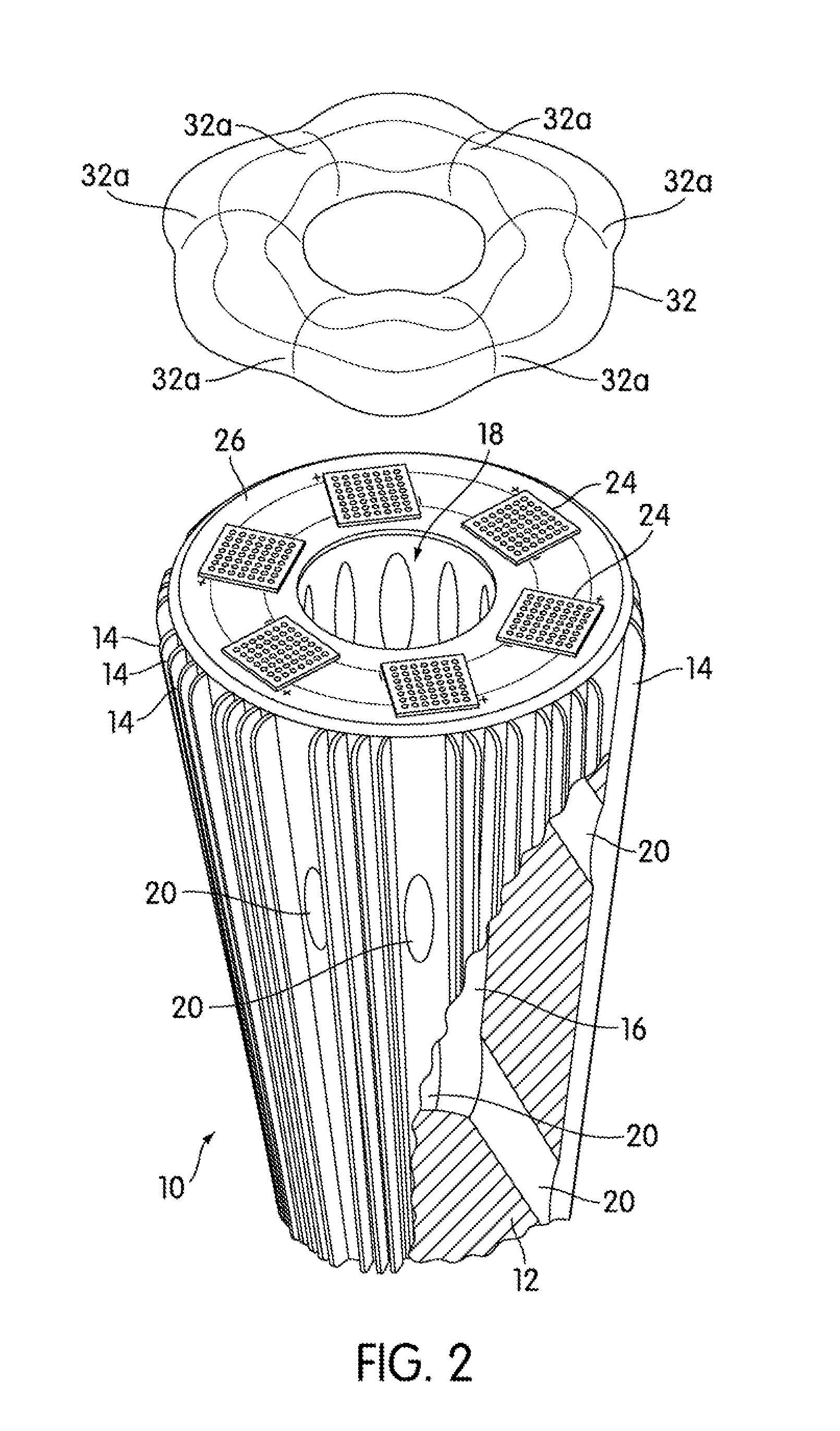Light emitting diode (LED) lighting device
a technology of leds and lighting devices, which is applied in semiconductor devices, discharge tube main electrodes, lighting and heating apparatus, etc., can solve the problem of low heat sink performance of leds at the center of the array, and achieve the effect of promoting air movemen
- Summary
- Abstract
- Description
- Claims
- Application Information
AI Technical Summary
Benefits of technology
Problems solved by technology
Method used
Image
Examples
first embodiment
[0038]A white light emitting LED lighting device 10 in accordance with the invention will now be described with reference to FIGS. 1 to 3 of the accompanying drawings. The LED lighting device 10 is configured for operation with a 110V (r.m.s.) AC (60 Hz) mains power supply as is found in North America and is intended for use as a direct replacement for an incandescent light bulb / reflector lamp.
[0039]Referring to FIGS. 1 to 3 the LED lighting device 10 comprises a generally conical shaped thermally conducting body 12. The body 12 is a solid body whose outer surface generally resembles a frustrum of a cone; that is, a cone whose apex or vertex is truncated by a plane that is parallel to the base (substantially frustoconical). The body 12 is made of a material with a high thermal conductivity (typically ≧150 Wm−1K−1, preferably ≧200 Wm−1K−1) such as for example copper (≈400 Wm−1K−1), aluminum (≈250 Wm−1K−1), anodized aluminum, an alloy of aluminum, a magnesium alloy, a metal loaded pla...
second embodiment
[0064]A white light emitting LED lighting device 10 in accordance with the invention will now be described with reference to FIGS. 7 and 8. The LED lighting device 10 is configured for operation with a 110V (r.m.s.) AC (60 Hz) mains power supply and is intended as a direct replacement for a halogen lamp.
[0065]FIG. 7 is a perspective representation of the LED lighting device 10 and comprises a generally frustoconical thermally conducting body 12 having a plurality of latitudinal heat radiating fins (veins) 14 circumferentially spaced around its outer curved surface. The form factor of the body 12 is configured to resemble a standard MR-16 (MR16) body shape enabling the device to be used directly in existing lighting fixtures. The body is made of a material with a high thermal conductivity, that is a thermal conductivity of typically ≧150 Wm−1K−1 and preferably ≧200 Wm−1K−1, such as for example aluminum, anodized aluminum, an alloy of aluminum, a magnesium alloy, a metal loaded plasti...
third embodiment
[0071]A white light emitting LED lighting device 10 in accordance with the invention will now be described with reference to FIGS. 9 and 10. The LED lighting device 10 is configured for operation with a 240V (r.m.s.) AC (50 Hz) mains power supply and is intended as a direct replacement for a incandescent light bulb.
[0072]FIG. 9 is a perspective representation of the LED lighting device 10 and comprises a thermally conducting body 12 that is configured such that its outer surface has a form factor that resembles the envelope (bulb) of a standard incandescent light bulb enabling the device to be used directly in existing lighting fixtures. The body is fabricated of a material with a high thermal conductivity (typically ≧150 Wm−1K−1, preferably ≧200 Wm−1K−1) such as for example aluminum, anodized aluminum, an alloy of aluminum, a magnesium alloy, a metal loaded plastics material or a thermally conductive ceramic. In this embodiment the outer surface of the body is multifaceted and has ...
PUM
 Login to View More
Login to View More Abstract
Description
Claims
Application Information
 Login to View More
Login to View More - R&D
- Intellectual Property
- Life Sciences
- Materials
- Tech Scout
- Unparalleled Data Quality
- Higher Quality Content
- 60% Fewer Hallucinations
Browse by: Latest US Patents, China's latest patents, Technical Efficacy Thesaurus, Application Domain, Technology Topic, Popular Technical Reports.
© 2025 PatSnap. All rights reserved.Legal|Privacy policy|Modern Slavery Act Transparency Statement|Sitemap|About US| Contact US: help@patsnap.com



